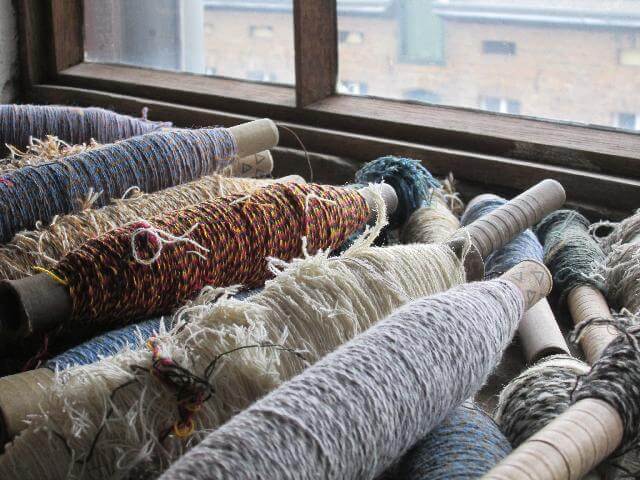Yarns cannot be recycled with your weekly trash. However, when made with suitable materials, some specific yarns are compostable and biodegradable.
There are methods to reuse your yarn at home, such as re-knitting or DIY projects.
Continue reading to discover why you should not throw away your yarn and how you can reuse it for projects around the house.
Is Yarn Recyclable?
Yarns cannot be recycled. This is surprising as most people consider yarn similar to wool or cotton, which may be readily recycled.
Unfortunately, It is just not possible. If you throw it in the recycle bin, it won’t miraculously convert into a fresh set of yarn.
Yarn isn’t accepted for recycling at many recycling centres since it isn’t included among the authorized recyclable items.
Don’t worry if you don’t have access to recycling for yarn disposal; there are still various choices accessible. You may use them in knitting or DIY crafts, for example.
Is Yarn Compostable?
If the yarn is composed of natural fibre, it can be composted.
However, if the yarn is synthetic and made of plastic, it cannot be composted. This is due to the difficulty in digesting plastic particles into the soil.
Acrylic yarns, polyester, nylon, and other synthetic fibres should not be composted since they will not decompose.
On the other hand, yarns created from natural fibres may be composted as they will degrade over time.
Is Yarn Biodegradable?
Yarn, thankfully for the environment, is biodegradable.
This applies to all-natural yarns. This is because they are derived from a plant, which is considered a living thing and will therefore disintegrate in the ground.
So, if you have a large stockpile of yarn, you won’t have to worry about environmental contamination. Yarns biodegrade after around five months.
However, if your yarn is composed of wool, it may take longer to biodegrade.
This is the only exception due to the density. It can sometimes take up to 50 years for the thread to biodegrade in settings like these.
Aside from wool yarns, you don’t have to worry about your yarns biodegrading indefinitely. Bacteria and other microbes will begin to operate on it within a few months.
Plastic is used in the production of specific yarns. Plastic materials include formation ingredients, which obstruct the biodegradation of these types of fibres.
The biodegradation of plastic materials can take thousands of years.
When plastic yarn biodegrades, it can become a concern for the ecosystem. As a result, it is preferable to avoid using these yarns for environmental reasons.
Creative Ways to Reuse Old Yarn.
Re-Knitting Strands of Yarn into a Multitude of Projects.
Whether you have an old yarn sweater you no longer wear or an old scarf that you love the colour of, old yarn favourites can be re-knit into new ones with a little bit of patience and skill.
One can unravel their old yarn and roll it into a tight ball in order to re-knit that yarn into new projects.
Reuse your yarn in knitting projects by following the steps below:
- Unravel old yarn pieces from the base. Yarn stitches should come apart with ease when pulled. If you’re struggling to pull apart the yarn, you’ve probably started from the wrong end.
- Wrap yarn around itself time and time again to create a ball. The yarn will begin to accumulate, and the ball will continue to grow. Continue until all yarn is wrapped in a tight ball.
- Find your favourite knitting projects and instructions online.
- Create a new masterpiece from your recycled yarn.
Recycling Old Yarn in Your Do-It-Yourself Projects.
The multitude of DIY projects that could incorporate yarn is endless. The best thing about DIY projects is that you can change a project based on your preferences.
Therefore, yarn can be used in your DIY projects for any required purpose. Due to its similarity to string, yarn is a must-have for all DIT enthusiasts.
One of the more commonly known methods to recycle yarn is to make pom-poms for hats or other crafts.
Follow the steps below to create Do-It-Yourself Fast Easy Pom-Poms:
- To keep the yarn from unravelling, tuck the end between your fingers. When you’re wrapping, remember not to let go.
2. Next, wrap the yarn over three or four fingers, leaving the thumb unwrapped. The size of the resulting pom-pom depends on how many fingers you wrap around. Wrap loosely because the more you wrap, the tighter it gets.
3. Carefully remove the yarn from your hand after you’re comfortable with the volume. Logically assemble everything. You wrapped it too tightly if it comes off in a jumble. Wrap a little more loosely this time.
4. Wrap a 6-inch (15cm) strip of wool around the DIY pom poms’ centre a few times.
5. Tie a tight knot at the end of the rope.



